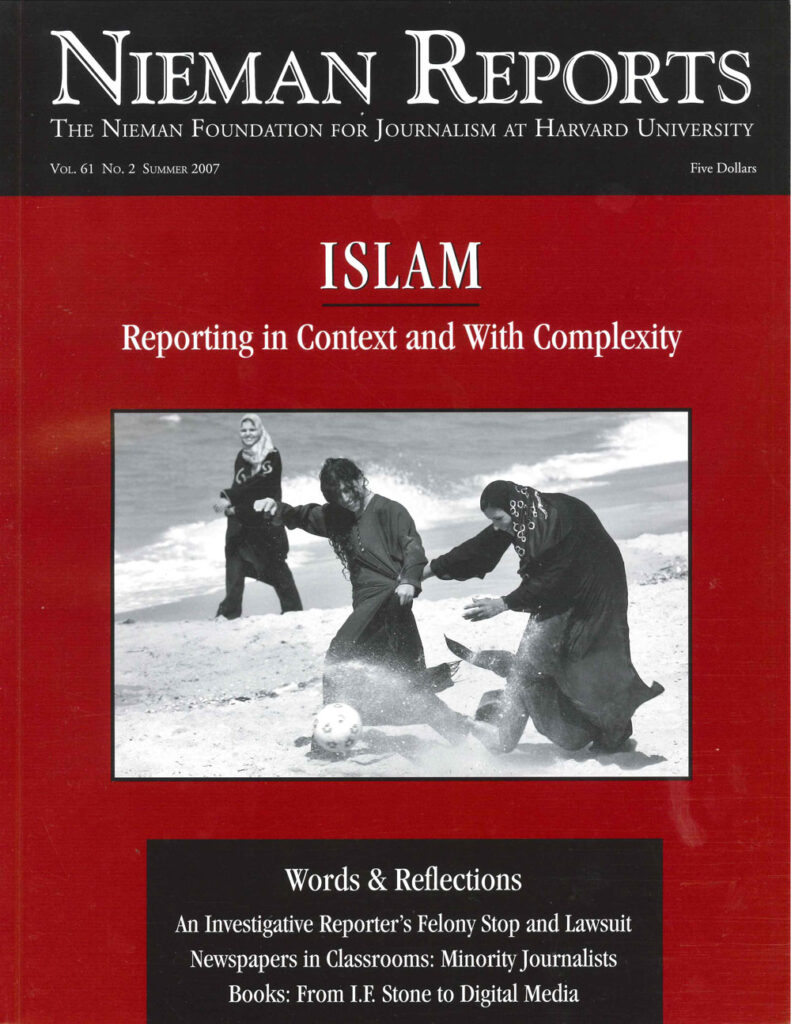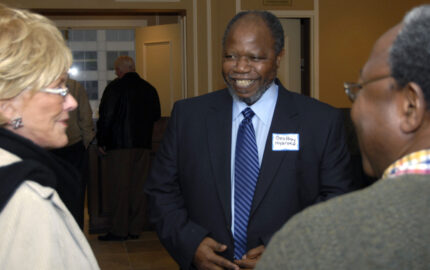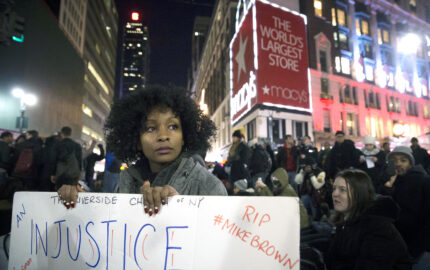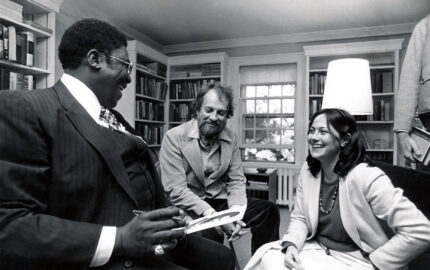Of all the questions asked about the war in Iraq, many were and still are directed at the press. Why didn't reporters ask more and better questions in the run-up to the invasion? Why are reporters so quick to accept official versions of events? Why is coverage so focused on the violence, ignoring the positive developments on the ground?
As varied as the questioners' perspective might be, a truth emerges just in their asking: In any war, public and political views about policy are shaped in some way by press coverage.
There are all kinds of wars.
In the exhaustively researched and compellingly written "The Race Beat: The Press, the Civil Rights Struggle, and the Awakening of a Nation," journalists Gene Roberts and Hank Klibanoff remind readers of the bloody war our nation fought over civil rights for black Americans in the 1950's and 1960's on mostly Southern battlefields.
Black Americans denied their rights as citizens—rights as basic as the vote and decent schools—would not be denied. Many whites saw the demands that black men and women judged reasonable as threats to their way of life—a life built on the assumed inferiority of blacks. Horrified whites would not easily give an inch, especially with the power of their states behind them.
This was a war with casualties. Thanks to the press, there were also witnesses.
Taking Sides
The guides to this history know the territory well. Roberts, a journalism professor at the University of Maryland, was a reporter at various Southern newspapers and national editor for The New York Times before becoming executive editor of The Philadelphia Inquirer and managing editor of the Times. Klibanoff, the managing editor for news at The Atlanta Journal-Constitution, was a reporter in Mississippi and at The Boston Globe before 20 years as a reporter and editor at the Inquirer.
This story starts in 1944—10 years before the Supreme Court's Brown v. Board of Education decision outlawed racial segregation in public schools—when Swedish academic Gunnar Myrdal's landmark book, "An American Dilemma," was published. In research and travels with his wife, Alva, Myrdal remained optimistic about the promise of American democracy even while observing the South's inhumane treatment of blacks. He wrote, "There is no doubt, in the writer's opinion, that a great majority of white people in America would be prepared to give the Negro a substantially better deal if they knew the facts." His conclusion, also quoted in "The Race Beat": "To get publicity is of the highest strategic importance to the Negro people."
The Negro press led the way. Before Northern white newspapers cared about appealing to black readers or noticed their struggles and everyday lives, the black-owned Chicago Defender pushed its circulation over 200,000, and The Afro-American competed with the Norfolk, Virginia-based Journal and Guide for readers. The powerhouse Pittsburgh Courier reached audiences across the country. Readers were hungry for stories and strong editorial voices not featured anywhere else.
The Negro press, threatened with sedition charges during World War II, continued to speak out about the irony of Negro soldiers fighting for freedom abroad while enduring brutal discrimination at home. The Arkansas State Press—run by civil rights advocates L.C. and Daisy Bates—bravely reported the violent showdown over the 1957 integration of Central High in Little Rock. But it could not survive the advertising boycott that followed. Black reporter L. Alex Wilson had reported from the Korean War, but it was in Little Rock that he was badly injured, his refusal to show fear a provocation for angry whites.
As the civil rights story got bigger and bloodier, black journalists, because of their color, became targets of the mob who did not respect them as human beings or journalists. Others took the lead. The New York Times, which had misread the importance and scope of the Little Rock story, worked quickly to catch up. The paper sent Georgia-born Claude Sitton, whose Southern coverage would set the standard. Then there were the Southern editors who bucked local power and reader reaction with their fair coverage of "Bull" Connor's dogs and hoses and James Meredith's integration of Ole Miss: Harry Ashmore of the Charlotte News and the Arkansas Gazette; Ralph McGill at The Atlanta Constitution; Hodding Carter II in Greenville, Mississippi; Buford Boone in Tuscaloosa, Alabama; Hazel Brannon Smith in Lexington, Mississippi, and others. Most of them, like McGill, Jonathan Daniels of the News & Observer of Raleigh, and Mark Ethridge, publisher at the Courier-Journal of Louisville, at first took a moderate view for that time, favoring gradual progress and defending social separation. But their view of this issue evolved as they witnessed the injustice of separate but equal.
These newspapers—led by courageous editors—were minority voices in a Southern press that supported and often led massive resistance to change. At The Charleston (S.C.) News and Courier, the editor, Tom Waring, Jr., supported the Citizens' Councils organized to intimidate blacks and reaffirm segregation after the Brown decision. James J. Kilpatrick, editor of the Richmond News Leader, led resistance efforts in Virginia. Known for his attention to the fine points of grammar and word usage, Kilpatrick had no trouble fitting the work "mongrelization" into his writing.
In 1963, in an essay for The Saturday Evening Post, Kilpatrick wrote: "The Negro race, as a race, is in fact an inferior race .... When the Negro today proclaims or demands his 'equality,' he is talking of equality within the terms of Western civilization. And what, pray, has he contributed to it? Putting aside conjecture, wishful thinking and a puerile jazz-worship, what has he in fact contributed to it? The blunt answer, may it please the court, is very damned little." Carrying his headline "The Hell He Is Equal," this essay was spiked after the bombing of a Birmingham, Alabama church killed four little girls.
While photographs in Life magazine and other publications gripped the world, it was the infant medium of television that came of age with the movement; TV proved its power as it conveyed graphic pictures of brutality into America's living rooms. ABC interrupted the movie "Judgment at Nuremberg" to broadcast images of troopers unleashing tear gas and nightsticks on marchers trying to cross the Edmund Pettus Bridge on the way from Selma to Montgomery, Alabama in March 1965. Viewers observed the obvious parallels and were horrified.
Eventual broadcast giants—Howard K. Smith and John Chancellor—went South early in their careers and filed visual reports on the violence with which protestors were met and the nonviolent responses they saw. The Reverend Martin Luther King, Jr. realized that TV and the civil rights struggle were made for each other, and he used coverage of racists' rage to wake up the rest of America.
Reading "The Race Beat" brings alive the datelines that exposed a country's raw wounds not so long ago: Selma, Birmingham, Little Rock. It also offers a lesson in the history of journalism. Reporters, editors and photographers worked hard to stay outside of this story—some might say the story of their time. Eventually they realized that finding truth amid chaos is not a simple task. Their honest search, which these authors explore and describe well, is very different from the "on the one hand, on the other hand" approach to reporting that today passes for balance but too often fails to illuminate the essence of the story or why it matters.
Mary C. Curtis, a 2006 Nieman Fellow, is a columnist at The Charlotte Observer in North Carolina. "The Race Beat" won the 2007 Pulitzer Prize for History.
As varied as the questioners' perspective might be, a truth emerges just in their asking: In any war, public and political views about policy are shaped in some way by press coverage.
There are all kinds of wars.
In the exhaustively researched and compellingly written "The Race Beat: The Press, the Civil Rights Struggle, and the Awakening of a Nation," journalists Gene Roberts and Hank Klibanoff remind readers of the bloody war our nation fought over civil rights for black Americans in the 1950's and 1960's on mostly Southern battlefields.
Black Americans denied their rights as citizens—rights as basic as the vote and decent schools—would not be denied. Many whites saw the demands that black men and women judged reasonable as threats to their way of life—a life built on the assumed inferiority of blacks. Horrified whites would not easily give an inch, especially with the power of their states behind them.
This was a war with casualties. Thanks to the press, there were also witnesses.
Taking Sides
The guides to this history know the territory well. Roberts, a journalism professor at the University of Maryland, was a reporter at various Southern newspapers and national editor for The New York Times before becoming executive editor of The Philadelphia Inquirer and managing editor of the Times. Klibanoff, the managing editor for news at The Atlanta Journal-Constitution, was a reporter in Mississippi and at The Boston Globe before 20 years as a reporter and editor at the Inquirer.
This story starts in 1944—10 years before the Supreme Court's Brown v. Board of Education decision outlawed racial segregation in public schools—when Swedish academic Gunnar Myrdal's landmark book, "An American Dilemma," was published. In research and travels with his wife, Alva, Myrdal remained optimistic about the promise of American democracy even while observing the South's inhumane treatment of blacks. He wrote, "There is no doubt, in the writer's opinion, that a great majority of white people in America would be prepared to give the Negro a substantially better deal if they knew the facts." His conclusion, also quoted in "The Race Beat": "To get publicity is of the highest strategic importance to the Negro people."
The Negro press led the way. Before Northern white newspapers cared about appealing to black readers or noticed their struggles and everyday lives, the black-owned Chicago Defender pushed its circulation over 200,000, and The Afro-American competed with the Norfolk, Virginia-based Journal and Guide for readers. The powerhouse Pittsburgh Courier reached audiences across the country. Readers were hungry for stories and strong editorial voices not featured anywhere else.
The Negro press, threatened with sedition charges during World War II, continued to speak out about the irony of Negro soldiers fighting for freedom abroad while enduring brutal discrimination at home. The Arkansas State Press—run by civil rights advocates L.C. and Daisy Bates—bravely reported the violent showdown over the 1957 integration of Central High in Little Rock. But it could not survive the advertising boycott that followed. Black reporter L. Alex Wilson had reported from the Korean War, but it was in Little Rock that he was badly injured, his refusal to show fear a provocation for angry whites.
As the civil rights story got bigger and bloodier, black journalists, because of their color, became targets of the mob who did not respect them as human beings or journalists. Others took the lead. The New York Times, which had misread the importance and scope of the Little Rock story, worked quickly to catch up. The paper sent Georgia-born Claude Sitton, whose Southern coverage would set the standard. Then there were the Southern editors who bucked local power and reader reaction with their fair coverage of "Bull" Connor's dogs and hoses and James Meredith's integration of Ole Miss: Harry Ashmore of the Charlotte News and the Arkansas Gazette; Ralph McGill at The Atlanta Constitution; Hodding Carter II in Greenville, Mississippi; Buford Boone in Tuscaloosa, Alabama; Hazel Brannon Smith in Lexington, Mississippi, and others. Most of them, like McGill, Jonathan Daniels of the News & Observer of Raleigh, and Mark Ethridge, publisher at the Courier-Journal of Louisville, at first took a moderate view for that time, favoring gradual progress and defending social separation. But their view of this issue evolved as they witnessed the injustice of separate but equal.
These newspapers—led by courageous editors—were minority voices in a Southern press that supported and often led massive resistance to change. At The Charleston (S.C.) News and Courier, the editor, Tom Waring, Jr., supported the Citizens' Councils organized to intimidate blacks and reaffirm segregation after the Brown decision. James J. Kilpatrick, editor of the Richmond News Leader, led resistance efforts in Virginia. Known for his attention to the fine points of grammar and word usage, Kilpatrick had no trouble fitting the work "mongrelization" into his writing.
In 1963, in an essay for The Saturday Evening Post, Kilpatrick wrote: "The Negro race, as a race, is in fact an inferior race .... When the Negro today proclaims or demands his 'equality,' he is talking of equality within the terms of Western civilization. And what, pray, has he contributed to it? Putting aside conjecture, wishful thinking and a puerile jazz-worship, what has he in fact contributed to it? The blunt answer, may it please the court, is very damned little." Carrying his headline "The Hell He Is Equal," this essay was spiked after the bombing of a Birmingham, Alabama church killed four little girls.
While photographs in Life magazine and other publications gripped the world, it was the infant medium of television that came of age with the movement; TV proved its power as it conveyed graphic pictures of brutality into America's living rooms. ABC interrupted the movie "Judgment at Nuremberg" to broadcast images of troopers unleashing tear gas and nightsticks on marchers trying to cross the Edmund Pettus Bridge on the way from Selma to Montgomery, Alabama in March 1965. Viewers observed the obvious parallels and were horrified.
Eventual broadcast giants—Howard K. Smith and John Chancellor—went South early in their careers and filed visual reports on the violence with which protestors were met and the nonviolent responses they saw. The Reverend Martin Luther King, Jr. realized that TV and the civil rights struggle were made for each other, and he used coverage of racists' rage to wake up the rest of America.
Reading "The Race Beat" brings alive the datelines that exposed a country's raw wounds not so long ago: Selma, Birmingham, Little Rock. It also offers a lesson in the history of journalism. Reporters, editors and photographers worked hard to stay outside of this story—some might say the story of their time. Eventually they realized that finding truth amid chaos is not a simple task. Their honest search, which these authors explore and describe well, is very different from the "on the one hand, on the other hand" approach to reporting that today passes for balance but too often fails to illuminate the essence of the story or why it matters.
Mary C. Curtis, a 2006 Nieman Fellow, is a columnist at The Charlotte Observer in North Carolina. "The Race Beat" won the 2007 Pulitzer Prize for History.



